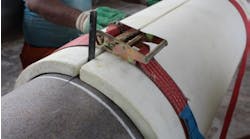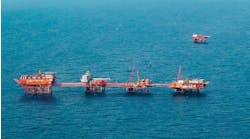Austenitic stainless steels enhance reputation in sour service tests
C.Wolfe, P-E.Arnvig
W.Wasielewska
Avesta Sheffield
R.Jargelius Pettersson
Swedish Institute
for Metals Research
Compilation of failure/non-failure lines for 22Cr (broken lines) and 25Cr (solid lines) duplex stainless steels and comparison with data points for 254 SMO and 654 SMO.Rigorous laboratory tests have been performed on two highly alloyed austenitic stainless steels simulating sour service environments. Results compared favorably with the performance of duplex stainless steels over a wide temperature range.
When testing for sour service in oil and gas production, there are key variables that can impact cracking propensity of corrosion-resistant alloys (CRAs). These are temperature, H2S partial pressure, pH and chloride concentration.
The standard test method is NACE TMO177, in which specimens are immersed in a solution saturated with H2S at ambient pressure. However, the latest tests were conducted in both the standard NACE environment at 25 degrees C and 90 degrees C, and in an autoclave environment at 150 degrees C. Loading methods were a combination of uniaxial tensile specimens (constant load), four-point bend, and U-bend specimens (constant total strain). Both the longitudinal and transverse directions were examined.
For the superaustenitic alloys under investigation, all materials were taken from standard production heats and were initially in the solution annealed condition. To examine the effect of cold work (and the associated increase in yield strength) laboratory-scale cold rolling (for plate) or cold drawing (for wire) was employed.
The first environment was that specified in NACE TM 0177 for CRAs (5 wt % NaCl acidified by the addition of 0.5 wt % glacial acetic acid to give a pH of about 3. At the end of the 720 hour test, the specimens were removed and examined in a light optical microscope for signs of cracking or other corrosive attack. Testing was also carried out on a limited range of specimens in the same environment at 90 degrees C.
Finally, tests were performed on four-point bend specimens in a static autoclave environment at 150 degrees C and elevated pressure (30bar). Specimens were placed in the autoclave, and the de-aerated NaCl solution added. The autoclave was pressurised with the test gas, comprising H2S, CO2 and N2 at ambient temperature, then sealed and heated to 150 degrees C. Solubility data were used to calculate the partial pressures of H2S and CO2 at the test temperature.
Results of the tests were as follows. At 25 degrees C there was no evidence of sulphide stress cracking in any annealed or cold worked specimen, nor was any pitting attack observed. At 90 degrees C, some superficial pitting was observed on the edges of the specimens of 254 SMO and cold worked 654 SMO, but there was no evidence of cracking.
In the autoclave testing at 150degrees C, no evidence of stress corrosion cracking was observed in annealed or cold worked 654 SMO tested under the most extreme conditions (1.4 bar H2S) and only slight pitting attack was present on the edges of cold worked specimens.
In the case of 254 SMO, no cracking occurred in annealed or cold worked material at a hydrogen sulphide partial pressure of 0.4 bar. At 0.9 bar H2S, there was slight surface attack on annealed specimens but this was not classified as stress corrosion cracking according to the NACE TM0177. At 1.4 bar H2S, stress corrosion cracking occurred on the annealed specimens.
In all three test series, some pitting occurred at edges and contact points. According to many accepted sources, the risk of the hydrogen-related failure, termed sulphide stress cracking (SSC), is most severe at ambient temperatures, with the risk decreasing as the temperature increases. The data suggests that both the superaustenitic steels are suitable candidate materials for SSC environments. Furthermore, the high strength levels attained from cold working have no measurable adverse effect on cracking resistance.
Comparing the results with data compiled by Ikeda, van Gelder et al., the performance of the two superaustenitic steels appears superior to that of the duplex steels at lower temperatures. In the autoclave testing at 150 degrees C the "no cracking" points for 654 SMO and 254 SMO also lie above the majority of the lines for the duplex steels.
Results for cold worked 254SMO and 654SMO may also be compared with data compiled by Barteri et al. for 22Cr and 25Cr duplex stainless steels strengthened to 970 MPa by cold work. The application limits of the heavily cold worked super-austenites are appreciably higher than those for the duplex steels, even though the strength levels of the austenitic steels are higher.
This comparison with duplex steels is confirmed by the two cases in which duplex steels were included in the present test series. At 90 degrees C, a 22Cr duplex steel exhibited extensive cracking after testing at 0.1bar H2S (compared with the absence of cracking for 654 SMO and 254 SMO at 1 bar H2S). At 150 degrees C, a 25Cr superduplex stainless steel suffered severe cracking at 0.9 bar H2S.
Austenitic stainless steels are generally regarded as more sensitive to anodic SCC - which is principally induced by the presence of chlorides and which increases in severity with increasing temperature - than to the hydrogen-induced SSC.
However, the results indicate that the two superaustenitic steels possess good resistance to anodic SCC at elevated temperatures. This may be due to the excellent pitting corrosion resistance of these alloys.
This is an edited verison of a paper presented this January at the Materials Technology for the Petroleum Industry conference in Trondheim.
Copyright 1997 Oil & Gas Journal. All Rights Reserved.


